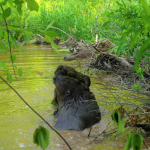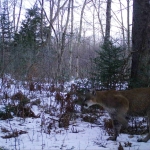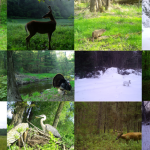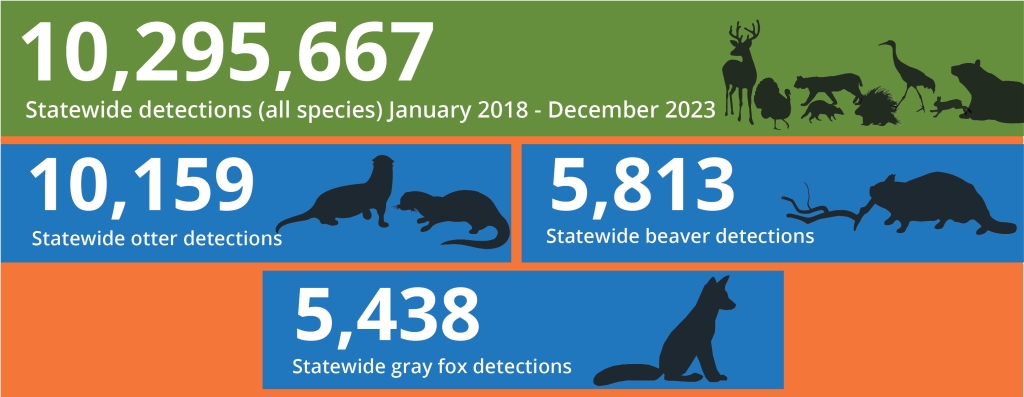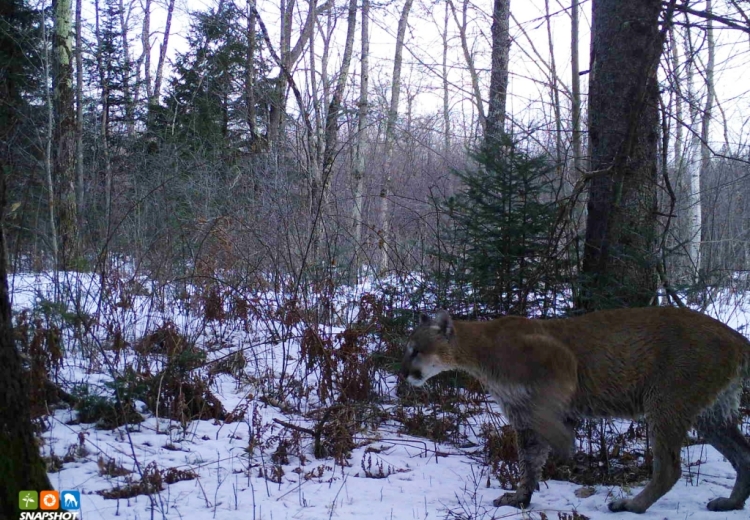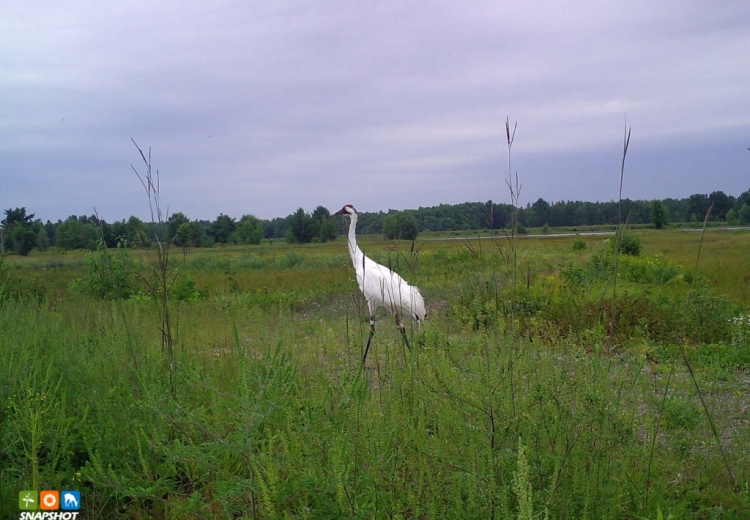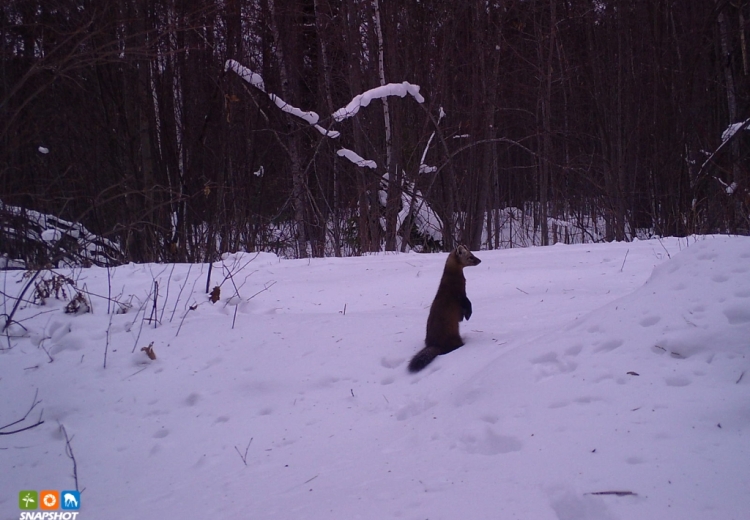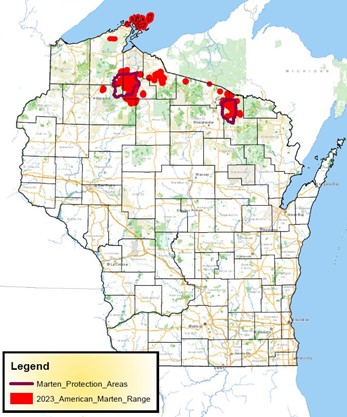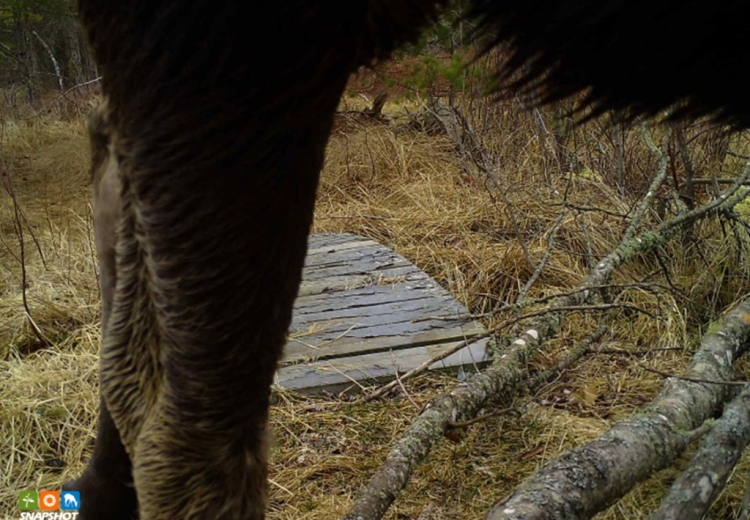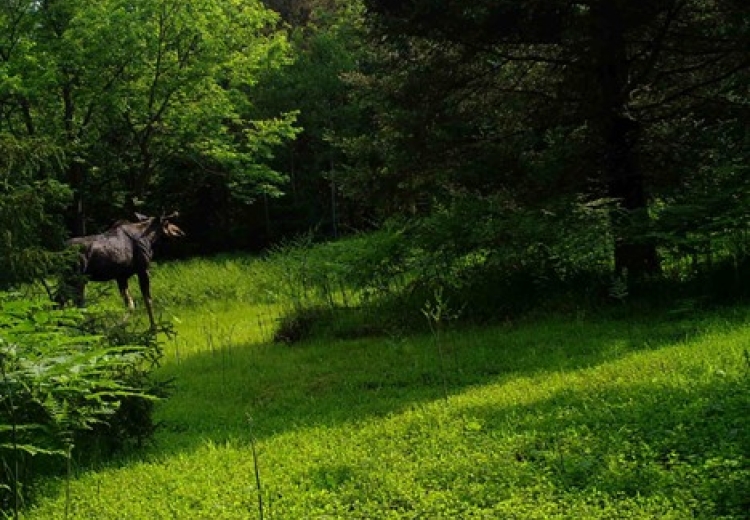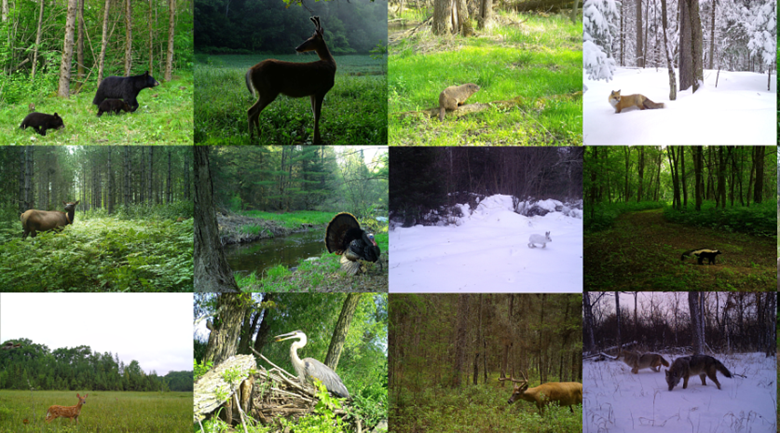Snapshot Wisconsin August 2024
New Data and Species on the Dashboard | Top 5 Rarest Species
It's that time of year again: another year's worth of data has been added to the Data Dashboard! This year is extra special, with data being added for three more Wisconsin species. We cover why only certain species are on the Dashboard and how this data directly impacts species management by the Wisconsin DNR. Then, we list the top five most rare species caught on Snapshot trail cameras, including a new detection from this past spring. Can you guess what species made the top five?
Would you like to receive Snapshot Wisconsin information and news sooner? Subscribe via GovDelivery and be the first to read the latest happenings with Snapshot Wisconsin and Wisconsin wildlife research.
- Snapshot Wisconsin Trail Camera Project - Sign up for emails about new Snapshot Wisconsin newsletters.
- Snapshot Wisconsin Educator's Bulletin - Sign up for emails about using Snapshot in classroom and outreach.
Three New Species + 2023 Data Added to the Data Dashboard!
Gray fox, beaver and otter join the 19 other species of data you can explore and download.
Some species rarely appear on Snapshot trail cameras. Who made it into our top five list?
New Resource: Snapshot Photo Library
Handpicked by the Snapshot team, five hundred sixty-six amazing photos are now available for viewing and downloading on the Snapshot Photo Library!
Three New Species + 2023 Data Added to the Data Dashboard!
When launched in 2020, the Data Dashboard provided Snapshot trail camera data for 19 Wisconsin species. New data has been added each year, and the Snapshot team is happy to announce that not only is the 2023 data now available, but three new species have also been added! The addition of gray foxes, beavers, and otters makes 22 species you can learn about and download data from the Dashboard. Why are these species being included now? It comes down to accuracy and ensuring the data are in a good state to be used in species management decisions.
Tricky Classifications
Before, these three furbearer species didn't meet the 95% accuracy threshold to be included on the Data Dashboard. An accuracy rate measures how often volunteers correctly classify a given species. This can be due to these species being less commonly captured on Snapshot trail cameras and being difficult to classify when they are captured.
Gray foxes are often misclassified as red foxes (since red foxes are more common and similar) or other canid species like coyotes. Beavers and otters are also usually captured at night while moving, sometimes meaning a not-quite-sharp image. As some volunteers can attest, blurry details can make it difficult to determine whether the animal is a beaver, otter, or similar-shaped mustelids like fisher or mink. There also tend to be fewer detections of these semi-aquatic species because it isn't always possible for a camera host to place their camera near a water source.
The Snapshot Wisconsin team has performed accuracy analysis research to determine classification accuracy for many species. For some species below the accuracy threshold, like gray fox, beaver, and otter, few enough photos can all be reviewed by an expert and included in the Data Dashboard.
Informing Species Management
Experts help identify difficult or rare species captured in Snapshot images. These experts include the Snapshot team and Wisconsin DNR staff, but most expert classifications are not only for hard-to-identify species.
Expert classification is needed when the Wisconsin DNR uses Snapshot data to help species committees make management decisions, like the Furbearer Advisory Committee (FAC) that oversees gray fox, beaver and otter species. Species committees help determine sustainable harvest quotas each year and are typically a diverse group representing government agencies, non-governmental organizations, tribal interests and conservation groups.
"We use Snapshot data to track 10 furbearer species, five of which require expert classification [fisher, otter, beaver, bobcat, gray fox]. When it's time to prepare for the annual furbearer species committee meeting, Snapshot team members take a species and go through all the triggers from the previous year," said Mackenzie McBride, Snapshot Wisconsin Operations Manager. "We also complete expert classification for wolves, turkey, grouse, and deer at certain times of the year. It's a revolving workload; all those different needs happen at different times."
We covered precisely how Snapshot data helped the FAC determine annual quotas for bobcats and fishers in the January 2023 newsletter. "Most data on the Dashboard are there because a decision support product was needed by a species committee, for example, the Furbearer Advisory Committee. A lot of work is done to turn photos into the data points that appear on the Dashboard," said Jennifer Stenglein, DNR Quantitative Research Scientist, who helps the FAC. Snapshot Wisconsin provides a unique data source for species committees that some sources, like harvest data, cannot: statewide and year-round data that management units of interest can summarize.
A Versatile Resource for Everyone
The same data used by scientists and the Wisconsin DNR is available to anyone through the Data Dashboard. "The Data Dashboard is a place where educators, scientists, high school classes, and undergrads can find good data, download it, and do some analysis or class projects," said Ryan Bemowski, Snapshot Data Scientist and designer of the Dashboard. "We get quite a few data requests that the Data Dashboard can fully fulfill."
McBride said one of the best ways you can contribute to the Data Dashboard is to help classify images on Zooniverse. "Classifying on Zooniverse helps the Data Dashboard grow and be a public resource to explore what species are detected in your area by county or ecological landscape and when they are most active," she said.
The Dashboard is constantly growing thanks to the many volunteers and the Snapshot team. With 22 species on the Dashboard now, the team may be working towards adding data for ruffed grouse, a very tricky bird to find in their dense forest habitat, not to mention classifying it with its similarities to other game fowl.
If you've been curious about exploring the Data Dashboard but not sure where to start, check out the latest education resource for grades 6-12, the Data Dashboard Scavenger Hunt, available on Snapshot In The Classroom under "Lesson Plans."
Top Five: Snapshot's Rarest Species
Some species in Wisconsin rarely appear on Snapshot cameras, which is why they don't show up on the Data Dashboard. When these hard-to-photograph animals do wind up in front of the lens, though, it provides a great opportunity for us to learn more about some of our state's most camera-shy residents. For this reason, we'd like to introduce you to five of the rarest species captured by Snapshot cameras!
1. Cougar, Puma concolor
The cougar is also known as a puma, mountain lion, panther, catamount, American lion and, in Ojibwa, mishibijn. Since Snapshot went statewide in 2018, there have only been four confirmed cougar detections on the trail cameras. The most recent was in May 2023 in Marinette County.
Cougars are native to Wisconsin, but breeding populations were eradicated by the early 1900s due to habitat loss and predator control efforts, and currently, there remains no evidence of a population in Wisconsin. DNR Large Carnivore Specialist Randy Johnson explains that today, individual cougar sightings likely represent males traveling from the nearest confirmed breeding populations in North Dakota, South Dakota and Nebraska.
"The majority of subadult male cougars disperse away from where they were born in their second year, whereas only about half of females disperse away from their natal range," Johnson said. He elaborated that currently, this lack of dispersed females in Wisconsin is one of the main reasons Wisconsin has yet to re-establish a breeding population.
While Snapshot has only captured four cougar detections across its cameras, Johnson says that over the last few years, the agency has been confirming an average of 10-20 reports per year and this trend is expected to continue to increase. These recently verified observations can be found on the DNR's cougar webpage, and the public is also encouraged to submit cougar reports and observations to the department via the Wildlife Observation tool. These reports are monitored regularly and are the primary way cougar activity is documented throughout the state.
2. Whooping Crane, Grus americana
Whooping cranes are a federally endangered bird with a global population estimated at only around 831 individuals (International Crane Foundation, 2024). With that in mind, it's rather impressive that Snapshot Wisconsin has had 10 confirmed trail camera detections of the bird since 2018. The most recent observation was from Jackson County in August 2023.
In the 1940s, this famous bird was at the edge of extinction after being overhunted and experiencing widespread habitat loss. At the lowest, the total population sat at just 21. While numbers are still low globally, Wisconsin's Necedah National Wildlife Refuge is now one of the best places to see whooping cranes. The refuge serves as a vital breeding ground for the Eastern Migratory Population before the birds begin their winter migration to the southeastern United States. Whooping cranes can also be spotted in Wisconsin at Horicon National Wildlife Refuge and White River Marsh State Wildlife Area.
All cranes within Wisconsin's Eastern Migratory Population (apart from a few wild born) are banded and fitted with GPS transmitters to aid with their tracking and continued recovery efforts. While Snapshot will continue to monitor trail cameras for confirmed observations of whooping cranes, anyone interested in learning more about these birds and their ongoing comeback story can visit the International Crane Foundation website or its location in Baraboo, Wisconsin.
3. Marten, Martes americana
Since 2018, there have been seven Snapshot camera detections of the American marten, the most recent of which was from a trail camera in Bayfield County just this past January!
The marten is currently endangered in Wisconsin, which is why it is so rarely detected on the trail cameras. In addition, it has a fairly small range within the state and exhibits behavior that lends itself to laying low.
The map above illustrates the marten distribution in Wisconsin (2023 National Heritage Inventory). Essentially, the species can be divided into three separate populations: the eastern and western units of the Chequamegon – Nicolet Forest and the Apostle Islands. On top of this small range, martens will also spend a good chunk of their time denning within trees where they raise young or underbrush and woody debris throughout the day. Their preference for mature, dense and complex forest habitats makes them hard to locate and is also one of the main reasons forest management practices are critically important to their well-being in the state.
Though currently protected at the state level, DNR Conservation Biologist Richard Staffen said there might be a new threat looming for the furbearer. "This species spends much time under the snow during winter," Staffen explained. "Essentially, they forage under the snowpack where they can remain out of sight from predators and effectively find small mammal prey. Because of this, however, the loss of snow cover in northern Wisconsin due to climate change is a major concern."
While it's hard to say for certain what the future holds for this elusive mammal, Snapshot and our volunteers will continue to play an important role in monitoring it.
4. Moose, Alces alces
The award for most Snapshot detections on this rare species list goes to (…drumroll…) the moose! Still, since 2018, there have been 20 Snapshot trail camera observations of this large cervid, the most recent being in Vilas County this past March!
Like other animals on this list, Wisconsin's established moose populations were eradicated in the early 1900s due to habitat loss and over-hunting. While the number of moose frequenting the state has increased since then, there is still no active breeding population. Thus, most confirmed sightings result from moose passing through from Minnesota or the Upper Peninsula of Michigan.
In 2023, 14 moose observations were reported to the DNR, eight of which came from Iron County. While sightings are uncommon, the public is again encouraged to report any that might occur through the DNR's online wildlife observation tool.
5. Golden Eagle, Aquila chrysaetos
Last but certainly not least, the golden eagle is one of Snapshot's hardest-to-detect species. To date, there has only been one confirmed observation of this elusive bird, which took place in Oconto County in March 2019.
Golden eagles and other birds that often hunt in open spaces can sometimes be more challenging to capture on Snapshot trail cameras due to the camera's placement, typically in more dense woody habitats. On top of that, golden eagles aren't very common to see in Wisconsin. After breeding in the Canadian Arctic, most are found here from October to April, particularly in the state's western half and especially in the Driftless Area. Unlike bald eagles, they do not associate with waterways but instead frequent uplands in search of squirrels, rabbits, turkeys and other prey.
Golden eagles can look very similar to immature bald eagles. Adult golden eagles are entirely brown and lack any white on the body, while immature goldens have white patches on the base of the tail and outer half of the underwings in flight. Meanwhile, immature bald eagles always show white on the inner, not outer, half of the wing. You can also look for the golden's feathered legs, tricolored beak, and smaller head. Contrary to popular myth, both species are nearly the same size. Although not currently endangered, golden eagles, alongside their bald counterparts, are federally protected under the Bald and Golden Eagle Protection Act, the Migratory Bird Treaty Act and the Lacey Act.
While Snapshot will be looking for any more trail camera observations of this species, keeping a trained eye on the winter skies could potentially prove just as lucky!
New Resource: Snapshot Photo Library
Explore the newly launched Snapshot Wisconsin Photo Library!
Click the link above to access some of the best trail cam images, handpicked from millions of photos. Search by species or county to find everything from familiar deer and turkeys to elusive fishers and bobcats. The library currently has 566 photos; regular updates ensure there's always something new to discover, so bookmark the library and check back often!

